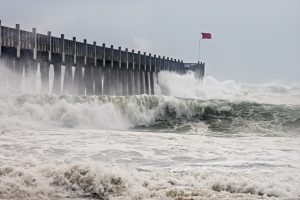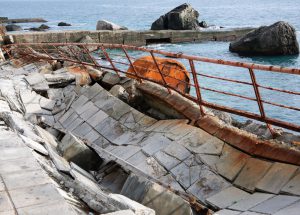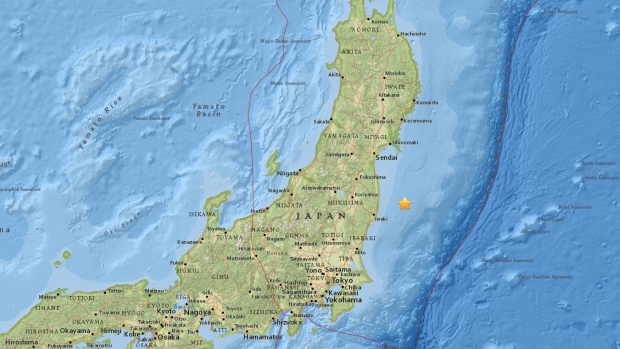Yesterday, at 6AM local time, the city of Fukushima, Japan experienced a 6.9 magnitude earthquake. The earthquake was 37 kilometers (23 miles) offshore, very close to where the 2011 earthquake began. Shortly after the quake, tsunami warnings were triggered in Fukushima and Miyagi, urging residents to evacuate immediately and head for higher ground.
Thankfully, there have been only three reported injuries to date, and the few hundred people who lost power have already had it restored. Fukushima residents live with the knowledge that an earthquake could strike at any time (especially since the devastating 2011 East Japan earthquake), and their emergency preparedness and resilience is remarkable. Evacuation alerts and emergency notifications for the tsunami were broadcast almost immediately, so residents had the information they needed to get to safety right away. Luckily, the largest wave was just over one meter high, and the tsunami warning was called off just a few hours after it was issued.
We are so relieved to see that the damage from this disaster has been minimal, especially since many residents in the area are still recovering from the 2011 earthquake and tsunami (the disaster that was the inspiration for ePACT). At the same time, this event validated just how outstanding the level of preparedness is for Fukushima residents, and how this is something we should all strive to achieve.
Most tsunamis happen in the Pacific Ocean because the Pacific Rim bordering the ocean has a large number of active earthquake zones. As a result, anyone living in this area not only has to prepare for earthquakes themselves, but the possibility of a tsunami as well.
 What is a Tsunami?
What is a Tsunami?
Tsunamis are giant waves caused by earthquakes or volcanic eruptions under the sea. As the waves travel inland, they build up to higher and higher heights as the depth of the ocean decreases. A tsunami usually consists of a series of waves, with sometimes hours between them.
What is a Tsunami Alert?
There are three levels of tsunami alert and knowing the difference between them will give you the information you need to prepare accordingly:
- Tsunami Watch: There is a potential threat of waves but no official confirmation; this gives residents time to prepare
- Tsunami Advisory: This is based on the potential for strong currents and advises everyone to stay away from shorelines/coastal areas
- Tsunami Warning: This is the highest level of warning and occurs when a tsunami has been observed forming offshore, with the potential to do damage as it arrives at land; residents are evacuated from the area immediately
What are the Natural Warning Signs for a Tsunami?
The Pacific Tsunami Warning Center gives these three natural warning signs for tsunamis. If you see any of these occur, you should get to higher ground immediately. Do not wait for official evacuation orders.
- Severe ground shaking from local earthquakes may cause tsunamis.
- As a tsunami approaches shorelines, water may recede from the coast, exposing the ocean floor, reefs and fish.
- Abnormal ocean activity, a wall of water, and an approaching tsunami create a loud “roaring” sound similar to that of a train or jet aircraft.
What Should I Do If a Tsunami Warning is Given?
 No matter where you are, when you hear the warning, you must get yourself to a safe space on higher ground, where the waves cannot reach you once they arrive on land. Alternatively, if you absolutely cannot get to higher ground, you can sometimes use the much higher floors of high rise towers. In places like Japan, vertical evacuation buildings have been specifically designed and/or chosen to provide sufficient elevation above the maximum water level. Unless you know a building can withstand a tsunami, getting to higher ground should be your first option wherever possible.
No matter where you are, when you hear the warning, you must get yourself to a safe space on higher ground, where the waves cannot reach you once they arrive on land. Alternatively, if you absolutely cannot get to higher ground, you can sometimes use the much higher floors of high rise towers. In places like Japan, vertical evacuation buildings have been specifically designed and/or chosen to provide sufficient elevation above the maximum water level. Unless you know a building can withstand a tsunami, getting to higher ground should be your first option wherever possible.
As you move to safety, try to do so calmly but quickly. Roads are likely to be busy with people trying to leave by vehicle, so if you can travel by foot or even on a bicycle, do so. Not only does this help move you faster than sitting in traffic, but keeps roads clear for emergency personnel to respond to areas that need their immediate help.
If you happen to be on a boat during a tsunami, it if often safer for you to remain at sea, heading for water that is at least 400m (1300 feet) deep. If you are in a port at the time of the warning, authorities will tell you what to do next, whether it’s heading for open water, or evacuating yourself and your fellow passengers to head for higher ground. Only return to port when you have been told it is safe to do so.
Finally, stay away from the coastlines until the tsunami warning has been lifted. Tsunamis can occur over the course of several hours, and returning too early to your home or place of work, can be dangerous. Wait for officials to tell you it is safe to return, and be aware that, if the tsunami reached inland, there may be additional hazards as a result.
How Do I Prepare for a Tsunami?
Just as earthquakes cannot be predicted, neither can a tsunami. However, making sure that you have a plan should one occur, is as important as your emergency kit.
- Create an evacuation plan and review it regularly with all of your household members (don’t forget to update it immediately if you move).
- Select meeting points on higher ground that you and your family know to reach ahead of time. You may wish to have more than one in case access is impacted.
- Make sure you have a way of connecting and communicating with your family and friends –ePACT gives you a reliable form of communication that is accessible anytime, anywhere.
Thinking about, and preparing for, these kinds of emergencies can be daunting, but yesterday’s earthquake in Fukushima is a great example of how emergency preparedness truly pays off. The resilience of Fukushima residents and their ability to thrive in challenging emergency situations is remarkable, and this was once again demonstrated with yesterday’s quake and tsunami warning. We hope that everyone has returned home safely and that this primer on tsunami’s helps you better prepare, wherever you live.
Terms and Conditions
All content provided on this blog is for informational purposes only. The owner of this blog makes no representations as to the accuracy or completeness of any information on this site or found by following any link on this site. The owner will not be liable for any errors or omissions in this information nor for the availability of this information. The owner will not be liable for any losses, injuries, or damages from the display or use of this information. This policy is subject to change at anytime.

